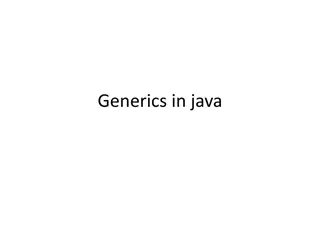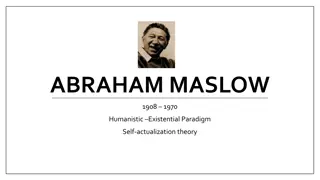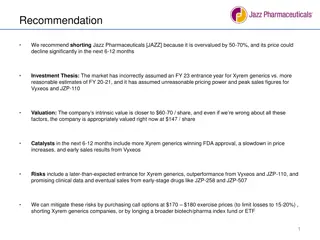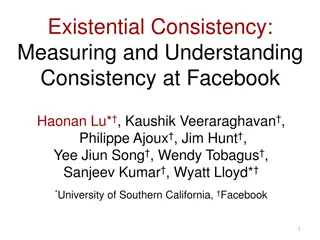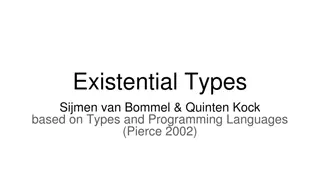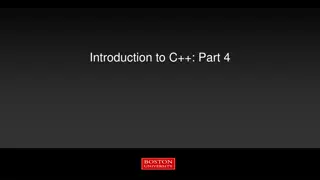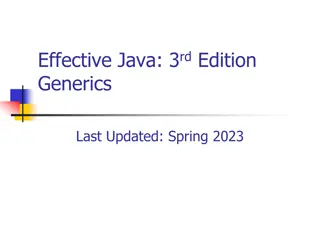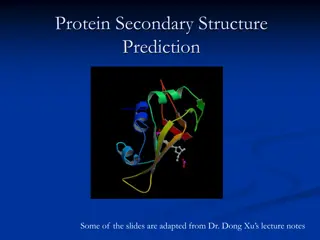Existential Generics and Information Structure
In this presentation, Zack Situ from the University of Edinburgh delves into the world of generics, discussing the nuances between generic and quantified statements, prevalence conditions, semantic proposals, and more. The exploration of existential generics and information structure sheds light on the complexities of linguistic interpretation.
Download Presentation

Please find below an Image/Link to download the presentation.
The content on the website is provided AS IS for your information and personal use only. It may not be sold, licensed, or shared on other websites without obtaining consent from the author.If you encounter any issues during the download, it is possible that the publisher has removed the file from their server.
You are allowed to download the files provided on this website for personal or commercial use, subject to the condition that they are used lawfully. All files are the property of their respective owners.
The content on the website is provided AS IS for your information and personal use only. It may not be sold, licensed, or shared on other websites without obtaining consent from the author.
E N D
Presentation Transcript
71. StuTS + 31. TaCoS, 28 May 2022 Existential Generics and Information Structure Zack (Zhengjie) Situ University of Edinburgh z.situ@ed.ac.uk 1
Presentation Plan Introducing Generics (3-7) Introducing Information Structure (8-11) Motivating my account (12-14) Discussion & Conclusion (15-18) Q & A 2
Generics Generalizing statements such as (1) tigers are striped (2) dogs are mammals (3) mosquitoes carry malaria Over a kind (or approx. members of) Unlike quantified statements: Most tigers are striped All dogs are mammals Prevalence conditions unspecified 3
Generic vs Quantified Statements Prevalence conditions How many of Ns is the P applicable to e.g. majority, half, some, 1/3, zero Generics are infelicitous answers to questions on prevalence: (4) Q: How many mosquitoes carry malaria? #A: Mosquitoes carry malaria. Common in English as bare plural (BP) 4
Generics: a Semantic proposal A semantic analysis? Long proven to be recalcitrant Debatable w/ther they have truth conditions Yet, most treat it as special quantification Lawlike, universal/majority-based Roughly paraphrasable as generally Tripartite LF: GEN x [N(x)] [P(x)] Quantifier Restrictor Nuclear Scope Quasi-Universal Hypothesis (QUH) 5
BPs, Generics and BP Generics QUH posits strong semantics as a default Problem explaining weak generic utterances BPs are argued to be weak indefinites Existential interpretation well-documented: (5) Students are in this room. Prominent with Stage-Level predicates Do BP generics have existential readings too? They do! 6
Existential BP Generics An example of existential BP generics: (6) PhD holders get tenured. No law guarantees that P applies to N! The weak force is hard to reconcile with the strong law-like one posited More prominent with emphasis/only: (7) PhD holders do get tenured. (8) Only PhD holders get tenured. Information Structure to the rescue? 7
Information Structure (IS) The same message, packaged differently (9) a. Noam published a new book b. NOAM published a new book c. Noam published a new BOOK d. Noam PUBLISHED a new book Which part of utterance is informative, in what way, relative to Context Messy terminology alert! 8
IS: two basic distinctions Givenness -What is asserted/new (focus) -What is assumed/old (background) Aboutness -What the utterance is about (topic) -What the speaker has to say (comment) (10) a. What does Jane study? b. Jane studies linguistics. Topic | Comment Background | Focus 10
Linguistic marking of IS Word Order, Morphology, Phonology etc Today s focus (no pun intended) will be: Givenness: Focus sensitive particles - only, also, too, even Aboutness: Question Under Discussion - What about X? - What other than X also Y? - etc. 11
Motivating an pragmatic account Generic readings cross-linguistically common Yet no known language has a dedicated generic article. Apparent quantificational variability GEN posited to do heavy weightlifting While the observed context-sensitivity lends itself to independent IS notions 12
Association with Focus Focus marking highlights a set of contextually induced alternatives to the focus-marked (11) a. Mary only introduced [Bill]F to Sue. b. Mary only introduced Bill to [Sue]F. Let s now reconsider example (8) (8) Only PhD holders get tenured. The other reading component predicted All alternative degree holders not tenured e.g. Bacholars get tenured Master holders get tenured 13
Context-sensitivity to current QUD Unacceptable BP generics are considerably more felicitous as answers to a current QUD (12) a. # Mammals lay eggs. b. A: What animals lay eggs? B: Birds lay eggs. Fishes lay eggs. Mammals lay eggs. QUD concerns the availability/possibility, Weak existential denotation easily acceptable 14
Discussion: conceptual advantages BP generics quantificational force is variable Like, really variable: from weakest to strongest So positing a strong-as-default semantics is a priori no more plausible than the opposite A weak-as-default semantics has advantages: Pragmatics tend to strengthen meanings e.g. Scalar Implicatures: some vs some b.n. all Existentiality is unspecified for number This explains why the question-answer pair probing prevalence conditions is odd in (4) 15
Conclusion Known facts about BP generics: 1. variable quantificational force 2. potential context-sensitivity Lesser-known facts about BP generics: 1. more variable quantificational force Specifically, a weak indefinite/existential one 2. systematic potential context-sensitivity Specifically, manipulated by studied IS factors 17
Conclusion Current observations strongly prompt us to abandon the received view of QUH Together with notions from IS and discourse pragmatics, BP generics can have a default weak existential semantics x (N(x) P(x)). Replace truth-theoretic by felicity conditions In most instances where a generic is judged to be degraded, they are true in a strict sense. Interpretational variability explained by the open-ended nature of pragmatic implications 18
References Beaver, D. I., & Clark, B. Z. (2008). Sense and Sensitivity: How Focus Determines Meaning. John Wiley & Sons. B ring, D. (2016). (Contrastive) Topic. In C. F ry & S. Ishihara (Eds.) The Oxford Handbook of Information Structure (pp 64-85). OUP. Carlson, G. N., & Francis Jeffrey Pelletier. (1995). The Generic Book. University of Chicago Press. Cohen, A., & Erteschik-Shir, N. (2002). Topic, focus, and the interpretation of bare plurals. Natural Language Semantics, 10(2), 125-165. Cohen, A. (2004). Existential Generics. Linguistics and Philosophy, 27(2), 137-168. von Fintel, K. (1997). Bare plurals, bare conditionals, and only. Journal of Semantics, 14(1), 1-56. von Fintel, K. (2004). A minimal theory of adverbial quantification. In H. Kamp & B. H. Partee (Eds.), Context-dependence in the analysis of linguistic meaning (pp 137 175). Amsterdam, The Netherlands: Elsevier. Lewis, D. (1979). Scorekeeping in a language game. Journal of Philosophical Logic, 8(1), 339- 359. Pelletier, F. J., & Asher, N. (1997). Generics and defaults. In Handbook of logic and language (pp. 1125-1177). North-Holland. Roberts, C. (2012). Information structure: Towards an integrated formal theory of pragmatics. Semantics and Pragmatics, 5(6), 1-69. Rooth, M. (1992). A theory of focus interpretation. Natural Language Semantics, 1(1), 75-116. Sterken, R. K. (2015). Generics in context. Philosopher's Imprint, 15(21). Vallduv , E. (2016). Information structure. In M. Aloni & P. Dekker (Eds.), The Cambridge Handbook of Formal Semantics (pp. 728-755). Cambridge: Cambridge University Press. 19
Thank you to everyone for listening! Q & A 20


